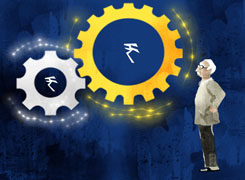What Mutual Fund Segment Should I Invest in for the Next 5 Years?
Ramalingam Kalirajan |10906 Answers |Ask -Follow
Mutual Funds, Financial Planning Expert - Answered on Nov 04, 2024
He has an MBA in finance from the University of Madras and is a certified financial planner.
He is the director and chief financial planner at Holistic Investment, a Chennai-based firm that offers financial planning and wealth management advice.... more

Dear Sir, In today's crumbling markets which segment of MF I should adopt for next 5 years. 2. Exactly which funds I should have in my portfolio
Let's examine a few suitable mutual fund segments and investment approaches.
1. Balanced Approach with Hybrid Funds
Hybrid funds offer a balanced mix of equity and debt. This blend allows for moderate growth with reduced volatility.
They allocate across asset classes, adjusting exposure based on market conditions. This can help protect capital during market downturns while offering growth potential.
In a crumbling market, hybrid funds act as a cushion. They give equity exposure without the extreme risk of a pure equity fund.
2. Benefits of Actively Managed Equity Funds
Actively managed funds are an ideal choice over index funds in volatile markets. Fund managers select quality stocks, making adjustments based on market trends.
They allow professionals to oversee your portfolio, unlike index funds that replicate indices without flexibility. Active funds can avoid poor-performing stocks that drag down index funds.
Actively managed funds also allow you to leverage the expertise of a qualified fund manager. This proactive management helps capture growth opportunities, even in fluctuating markets.
3. Debt Funds for Stability and Capital Preservation
Debt funds provide stability by investing in fixed-income securities like government bonds and corporate debt. This approach reduces exposure to market swings.
They’re ideal if you’re risk-averse or need capital protection. Returns may be modest, but they’re reliable, especially in volatile times.
Choose short- to medium-duration debt funds to minimise interest rate risks. This keeps your investment aligned with a 5-year goal while preserving capital.
4. Equity-Oriented Funds for Long-Term Growth Potential
For a 5-year period, equity-oriented funds can still be valuable. While risky, they offer potential for significant growth over time.
Consider large-cap or multi-cap equity funds. These focus on established companies, which are more resilient during market declines.
Multi-cap funds, in particular, give exposure to large, mid, and small-cap stocks. This diversification balances growth and risk.
5. Flexi-Cap Funds for Market Flexibility
Flexi-cap funds invest across market capitalisations, from large- to small-cap. This adaptability helps manage risk and seek growth.
In a fluctuating market, flexi-cap funds allow fund managers to shift to stable, large-cap stocks. They can later switch to smaller companies when markets stabilise.
This flexibility makes them ideal for a medium-term horizon, allowing managers to adjust based on market cycles and potential growth areas.
6. Disadvantages of Index Funds in Volatile Markets
Index funds mirror a market index and lack flexibility. This means they’ll include underperforming stocks if those stocks are part of the index.
When markets are down, index funds decline as well, with no flexibility to shift to stronger-performing stocks. This can limit their performance in challenging market conditions.
Actively managed funds are superior in turbulent times. Their fund managers select and avoid specific stocks, optimising returns based on market scenarios.
7. Regular Mutual Funds vs. Direct Plans
Regular plans offer an important benefit: access to advice from a Certified Financial Planner (CFP) and Mutual Fund Distributor (MFD). They guide on which funds align with your financial goals.
Direct plans may seem cheaper but lack advisory support. For a 5-year goal, informed decisions are crucial. Regular funds with professional guidance can help you make well-rounded choices.
A regular plan ensures ongoing monitoring and support. A CFP can adjust your portfolio when needed, helping you stay on track.
8. Tax Considerations in Mutual Fund Investments
Tax rules for mutual funds changed recently. For equity funds, long-term capital gains (LTCG) above Rs 1.25 lakh are taxed at 12.5%. Short-term gains are taxed at 20%.
For debt funds, gains are taxed as per your income tax slab. This can impact returns, especially if your income tax rate is high.
Choosing the right fund segment helps you align investments with tax efficiency. Balance between equity and debt to optimise returns with lower tax implications.
Suggested Mutual Fund Segments for a 5-Year Portfolio
Consider a blend of hybrid, flexi-cap, and equity-oriented funds. This portfolio provides growth and stability for medium-term goals.
Include short-duration debt funds to keep a safe portion of your investment. This portion will act as a financial cushion in case of sudden expenses or market declines.
Aim for funds with a proven track record in volatile markets. This ensures you’re investing with funds that have shown resilience over the long term.
Avoiding Real Estate and Annuities
For a 5-year investment horizon, avoid real estate and annuities. Real estate is illiquid, tying up funds, and is unpredictable in the short term.
Annuities typically focus on retirement, with limited flexibility or growth potential. Mutual funds provide greater liquidity and adaptability for a medium-term goal.
Finally
Choose a diversified portfolio with a mix of hybrid, actively managed equity, and debt funds. Avoid direct plans and index funds, and leverage expert guidance. A balanced approach will help you achieve stable growth despite market conditions.
Best Regards,
K. Ramalingam, MBA, CFP,
Chief Financial Planner,
www.holisticinvestment.in
https://www.youtube.com/@HolisticInvestment
You may like to see similar questions and answers below
Ulhas Joshi |280 Answers |Ask -Follow
Mutual Fund Expert - Answered on Mar 15, 2023
Ramalingam Kalirajan |10906 Answers |Ask -Follow
Mutual Funds, Financial Planning Expert - Answered on Apr 12, 2024
Ramalingam Kalirajan |10906 Answers |Ask -Follow
Mutual Funds, Financial Planning Expert - Answered on Aug 23, 2024
Ramalingam Kalirajan |10906 Answers |Ask -Follow
Mutual Funds, Financial Planning Expert - Answered on Jun 26, 2024
Ramalingam Kalirajan |10906 Answers |Ask -Follow
Mutual Funds, Financial Planning Expert - Answered on Oct 30, 2024
Ramalingam Kalirajan |10906 Answers |Ask -Follow
Mutual Funds, Financial Planning Expert - Answered on Dec 19, 2025
Nayagam P P |10859 Answers |Ask -Follow
Career Counsellor - Answered on Dec 19, 2025
Ramalingam Kalirajan |10906 Answers |Ask -Follow
Mutual Funds, Financial Planning Expert - Answered on Dec 19, 2025
Ramalingam Kalirajan |10906 Answers |Ask -Follow
Mutual Funds, Financial Planning Expert - Answered on Dec 19, 2025
Ramalingam Kalirajan |10906 Answers |Ask -Follow
Mutual Funds, Financial Planning Expert - Answered on Dec 19, 2025
Radheshyam Zanwar |6751 Answers |Ask -Follow
MHT-CET, IIT-JEE, NEET-UG Expert - Answered on Dec 19, 2025
Radheshyam Zanwar |6751 Answers |Ask -Follow
MHT-CET, IIT-JEE, NEET-UG Expert - Answered on Dec 19, 2025
Samraat Jadhav |2514 Answers |Ask -Follow
Stock Market Expert - Answered on Dec 18, 2025
Reetika Sharma |432 Answers |Ask -Follow
Financial Planner, MF and Insurance Expert - Answered on Dec 18, 2025
Reetika Sharma |432 Answers |Ask -Follow
Financial Planner, MF and Insurance Expert - Answered on Dec 18, 2025

























